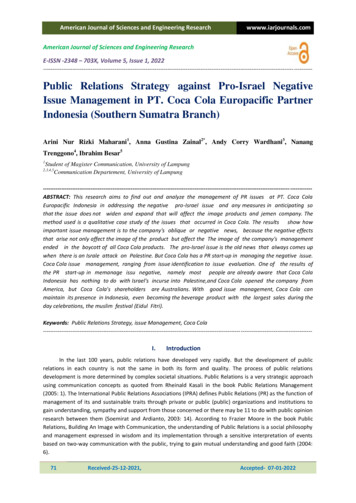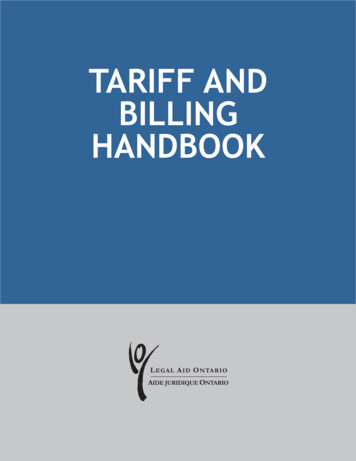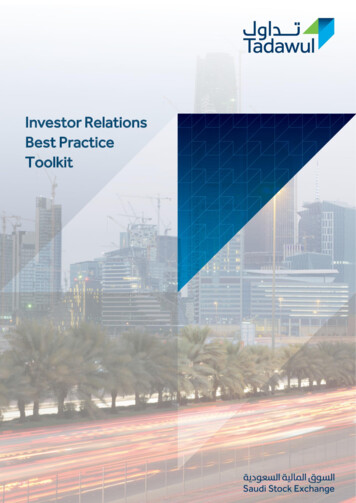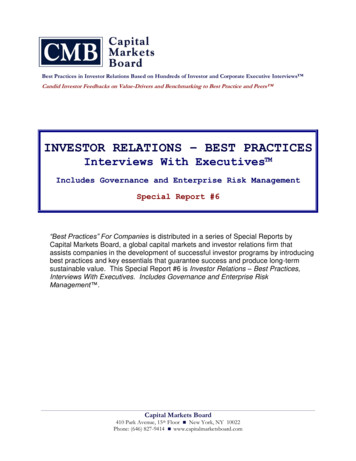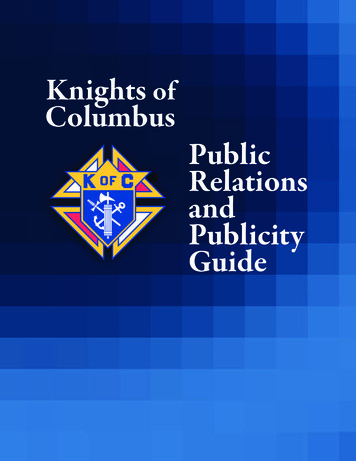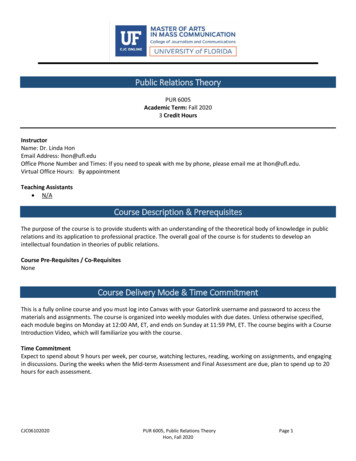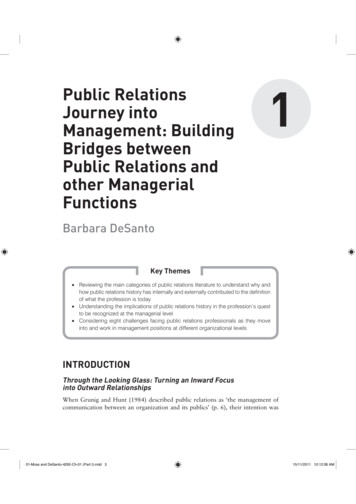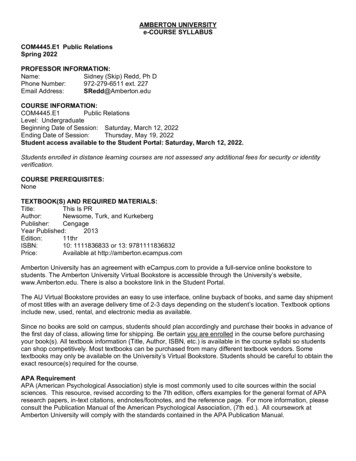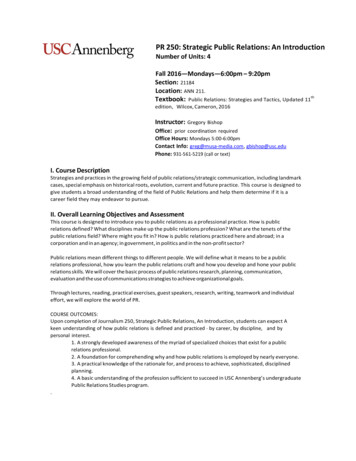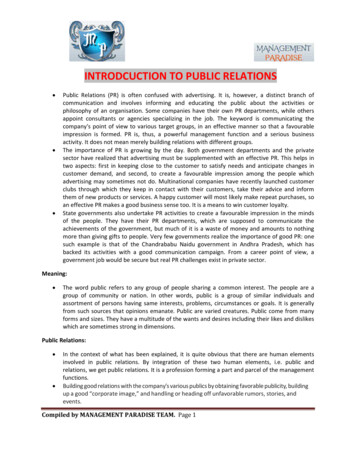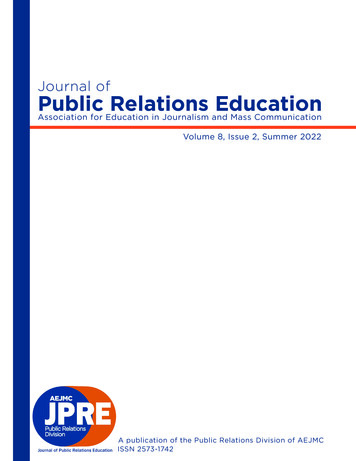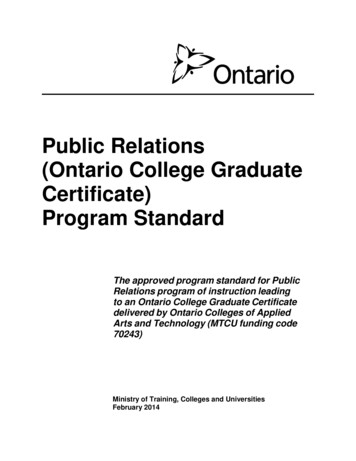
Transcription
Public Relations(Ontario College GraduateCertificate)Program StandardThe approved program standard for PublicRelations program of instruction leadingto an Ontario College Graduate Certificatedelivered by Ontario Colleges of AppliedArts and Technology (MTCU funding code70243)Ministry of Training, Colleges and UniversitiesFebruary 2014
Permission to ReproducePermission is hereby granted to the following institutions to reproduce thisdocument, in whole or in part, in print or by electronic means, for the followingspecific purposes, subject to the conditions that follow:1.2.By an Ontario college of applied arts and technology for the purposesof implementation of the program standard within a college program,including for the purpose of informing students, potential students,program advisory committees or others about programs of study.By an educational institution or school, for the purpose of informingprospective college students about programs of study at Ontariocolleges of applied arts and technology.Conditions:1.2.3.4.Every reproduction must be marked “ 2014, Queen’s Printer for Ontario”at the beginning of the document or any part of it that is reproduced.No other uses may be made of the document.The document may not be reproduced for sale.The Ministry may revoke the permission to reproduce at any time.For permission to copy this document, in whole or in part, for other purposesor by other institutions, please contact:Ministry of Training, Colleges and UniversitiesPrograms Branch, Program Standards and Evaluation UnitE-mail: psu@ontario.caInquiries regarding specific Public Relations (Ontario College GraduateCertificate) programs offered by colleges of applied arts and technology inOntario should be directed to the relevant college. 2014, Queen’s Printer for OntarioISBN 978-1-4606-3511-7 (PDF)
AcknowledgementsThe Ministry of Training, Colleges and Universities acknowledges with thanks thesignificant contribution of the many individuals and organizations whoparticipated in the development of this program standard. In particular, theMinistry of Training, Colleges and Universities would like to acknowledge theimportant roles of all individuals and organizations who participated in the consultations;the co-ordinators of Public Relations (Ontario College Graduate Certificate)Programs for their assistance throughout the project, the project officer wholed the development of the vocational standard, Camilla Wheeler, secondedfaculty member from George Brown College.
Table of ContentsI.Introduction . 1Development of System-Wide Program Standards . 1Program Standards . 1The Expression of Program Standards as Vocational Learning Outcomes. 2The Presentation of the Vocational Learning Outcomes . 2The Development of a Program Standard. 2Updating the Program Standard . 3II.Vocational Standard . 4Preamble. 4Synopsis of the Vocational Learning Outcomes. 7The Vocational Learning Outcomes . 9Glossary. 20
I.IntroductionThis document is the Program Standard for the Public Relations program ofinstruction leading to an Ontario College Graduate Certificate delivered byOntario colleges of applied arts and technology (MTCU funding code 70243).Development of System-Wide Program StandardsIn 1993, the Government of Ontario initiated program standards developmentwith the objectives of bringing a greater degree of consistency to collegeprogramming offered across the province, broadening the focus of collegeprograms to ensure graduates have the skills to be flexible and to continue tolearn and adapt, and providing public accountability for the quality and relevanceof college programs.The Program Standards and Evaluation Unit of the Ministry of Training, Collegesand Universities have responsibility for the development, review and approval ofsystem-wide standards for programs of instruction at Ontario colleges of appliedarts and technology.Program StandardsProgram standards apply to all similar programs of instruction offered by collegesacross the province. Each program standard for a postsecondary programincludes the following elements: Vocational standard (the vocationally specific learning outcomes whichapply to the program of instruction in question),Essential employability skills (the essential employability skills learningoutcomes which apply to all programs of instruction); andGeneral education requirement (the requirement for general educationin postsecondary programs of instruction).Collectively, these elements outline the essential skills and knowledge that astudent must reliably demonstrate in order to graduate from the program.Individual colleges of applied arts and technology offering the program ofinstruction determine the specific program structure, delivery methods and othercurriculum matters to be used in assisting students to achieve the outcomesarticulated in the standard. Individual colleges also determine whether additionallocal learning outcomes will be required to reflect specific local needs and/orinterests.I - Introduction
The Expression of Program Standards as Vocational LearningOutcomesVocational learning outcomes represent culminating demonstrations of learningand achievement. They are not simply a listing of discrete skills, nor broadstatements of knowledge and comprehension. In addition, vocational learningoutcomes are interrelated and cannot be viewed in isolation of one another. Assuch, they should be viewed as a comprehensive whole. They describeperformances that demonstrate that significant integrated learning by graduatesof the program has been achieved and verified.Expressing standards as vocational learning outcomes ensures consistency inthe outcomes for program graduates, while leaving to the discretion of individualcolleges, curriculum matters such as the specific program structure and deliverymethods.The Presentation of the Vocational Learning OutcomesThe vocational learning outcome statements set out the culminatingdemonstration of learning and achievement that the student must reliablydemonstrate before graduation.The elements of the performance for each outcome define and clarify the leveland quality of performance necessary to meet the requirements of the vocationallearning outcome. However, it is the performance of the vocational learningoutcome itself on which students are evaluated. The elements of performanceare indicators of the means by which the student may proceed to satisfactoryperformance of the vocational learning outcome. The elements of performancedo not stand alone but rather in reference to the vocational learning outcome ofwhich they form a part.The Development of a Program StandardIn establishing the standards development initiative, the Government determinedthat all postsecondary programs of instruction should include vocational skillscoupled with a broader set of essential skills. This combination is consideredcritical to ensuring that college graduates have the skills required to besuccessful both upon graduation from the college program and throughout theirworking and personal lives.A program standard is developed through a broad consultation process involvinga range of stakeholders with a direct interest in the program area, includingemployers, professional associations, universities, secondary schools andprogram graduates working in the field, in addition to students, faculty andadministrators at the colleges themselves. It represents a consensus of2I - Introduction
participating stakeholders on the essential learning that all program graduatesshould have achieved.Updating the Program StandardThe Ministry of Training, Colleges and Universities will undertake regular reviewsof the vocational learning outcomes for this program to ensure that the PublicRelations (Ontario College Graduate Certificate) Program Standard remainsappropriate and relevant to the needs of students and employers across theProvince of Ontario. To confirm that this document is the most up-to-daterelease, please contact the Ministry of Training, Colleges and Universities at theaddress or email address noted on the inside cover page.I - Introduction3
II. Vocational StandardAll graduates of Public Relations Graduate Certificate programs have achievedthe ten (10) vocational learning outcomes (VLOs) listed in the following pages.PreambleManaging an organization’s relationships with its diverse stakeholders* (i.e.,those individuals, groups or other organizations that are impacted by or mayimpact the organization), is the strategic management function of public relations.Public relations activities focus on planning, implementing and evaluatingtargeted communication and stakeholder* engagement strategies to achievemutual understanding and realize organizational goals; strong written and oralcommunication skills are essential for those choosing to work in the field.Depending on the organization, public relations professionals may focus onspecific functions or stakeholder* relationships (e.g., media relations, communityrelations, government relations, internal/corporate communications,investor/donor relations, reputation/crisis/issues management, etc.) and/orspecific public relations activities (e.g., communication and social mediacampaigns, Web content development, special events, fundraising, etc.). TheGraduate Certificate program provides graduates with the opportunity tocoordinate and contribute to the planning, implementation and evaluation ofpublic relations activities to manage a range of stakeholder* relationships andissues and achieve organizational objectives.Graduates build on their prior post-secondary education and experience toperform a more specialized range of activities or focus on specific public relationsfunctions, stakeholder* relationships or issues management.Graduates of the Public Relations Graduate Certificate program write and editclear, accurate, targeted copy, aligned to organizational objectives, appropriatefor the chosen channel(s)* and to a specified deadline. This requires adherenceto style guides and templates and compliance with ethical and legal obligationsrelated to intellectual property, plagiarism, privacy and confidentiality ofinformation, and factual accuracy. Graduates use writing style, language andtone appropriate for the purpose of the communication (e.g., informing vs.persuading) and channel(s)* (e.g., print, broadcast, speech, digitalcommunications, social media applications, Web content, etc.). Graduates alsoadapt their language, tone and style to engage stakeholders* in a range of publicrelations settings and activities (e.g., interviews, meetings, internal and mediabriefings, news conferences, special events, trade shows, etc.). Their conductshould promote equity, inclusion and collaboration and follow protocols andpractices for a range of public relations functions. Strategies and tools graduatesselect to build and maintain mutually-beneficial stakeholder* relationships may4II - Vocational Standard
include: communicating professionally and ethically with stakeholders*;managing contact lists; investigating the benefits, resources and networkingopportunities associated with membership in professional associations; andmaintaining a professional online presence.Graduates coordinate and contribute to the planning and implementation ofvarious public relations activities by analyzing key stakeholder* relationship andissues management needs, developing clear, measurable communicationobjectives and project or tactical budgets, selecting strategies and tactics toachieve them, executing logistics and completing tasks. They follow instructions,use knowledge of public relations theory and practices, apply projectmanagement skills and tools, and work collaboratively on project teams.Research tools and results are used, and analytical skills and evaluationtechniques are applied, to guide the planning of public relations activities andevaluate their impact against objectives and metrics.Graduates also produce effective, timely visual, audio, multimedia and interactivecommunications using fundamental design principles, accessibility standards anda range of tools, applications and elements (e.g., cameras, scanners, photoediting, design, presentation, desktop and/or Web publishing software, socialmedia applications, images, graphics, animations, hypertext, etc.).Graduates comply with and support others to work in compliance with relevantprofessional association and industry codes of ethics, public relationsprofessional standards and practices, legal obligations, protocols and policies, tosupport organizational objectives and to serve the public interest. This mayinclude application of principles of corporate social responsibility to publicrelations activities and the workplace.The speed, volume, accessibility and impact of information on organizations andtheir stakeholder* relations requires graduates to monitor emerging social andeconomic trends, local, national and global issues. This requires that they identifyrelevant trends and issues and determine the reliability, authority, legality andcurrency of information and its source. Keeping current enhances graduates’work performance and guides their personal professional development.Graduates also assess the selection and implications of current and emergingtechnologies to enhance the quality and delivery of public relations activities andorganizational effectiveness.The need for managing mutually beneficial stakeholder* relationships throughcommunication and engagement applies across all employment sectors andindustries. Opportunities for graduates of Public Relations programs exist withina broad range of large and small commercial, government and not-for-profitorganizations, and public relations agencies serving one or more sector orindustry. Entry-level positions for graduates may encompass a variety of publicII - Vocational Standard5
relations activities or specialize on a particular public relations function, activity orstakeholder* relationship.There are opportunities for graduates to pursue further educational qualifications.Graduates should contact individual colleges and universities for further details.Endnote: The Ontario Council on Articulation and Transfer (ONCAT) maintainsthe provincial postsecondary credit transfer portal, ONTransfer,at http://www.ontransfer.ca.*See Glossary6II - Vocational Standard
Synopsis of the Vocational Learning OutcomesPublic Relations (Ontario College Graduate Certificate)The graduate has reliably demonstrated the ability to1. coordinate and contribute to the planning of public relationsactivities, including the development of clear, measurablecommunication objectives and project or tactical budgets andselection of strategies, tactics, tools and resources to manage arange of stakeholder* relationships and issues and achieveorganizational objectives.2. coordinate, contribute to and adapt the implementation of strategiesand tactics and the management of budgets and resources toachieve communication objectives and meet activity guidelines andrequirements.3. write and edit clear, accurate, targeted copy aligned toorganizational objectives, appropriate for the chosen channel(s)*and to a specified deadline.4. produce effective, accessible, and timely print, digital andmultimedia communications, independently and collaboratively, tomanage specific stakeholder* relations and/or issues and achieveorganizational objectives.5. use research results and analytical skills to guide thedevelopment of communication objectives and public relationsactivities, evaluate their impact, and support organizationalobjectives and stakeholder* relationships.6. engage stakeholders* by adapting language, tone andpresentation style to the public relations purpose, situation,audience and channel(s)*.7. comply with and support others to work in accordance withrelevant professional association and industry codes of ethics,public relations professional standards and practices, and legalobligations, protocols and policies.8. monitor emerging social and economic trends, and local, nationaland global issues to guide the planning and implementation of publicrelations strategies and tactics and support organizationaleffectiveness, stakeholder* relationships and ongoing personalprofessional development.II - Vocational Standard7
9. assess the selection and implications of current and emergingtechnologies on the quality and delivery of public relationsactivities and on organizational effectiveness.10. select strategies and tools to build and manage stakeholder*relationships to support public relations activities, organizationalobjectives and career development.*See GlossaryNote: The learning outcomes have been numbered as a point of reference;numbering does not imply prioritization, sequencing, nor weighting ofsignificance.8II - Vocational Standard
The Vocational Learning Outcomes1.The graduate has reliably demonstrated the ability tocoordinate and contribute to the planning of public relations activities,including the development of clear, measurable communicationobjectives and project or tactical budgets and selection of strategies,tactics, tools and resources to manage a range of stakeholder*relationships and issues and achieve organizational objectives.Elements of the Performance Analyze key stakeholder* relationship and issues management needs oforganizations in a range of sectors (e.g., commercial, not-for-profit,government, etc.) and industriesDistinguish between goals, objectives, strategies and tacticsCoordinate and contribute to the selection of strategies, tactics, tools andresources appropriate for different public relations functions (e.g., mediarelations, community relations, government relations, internal/corporatecommunications, investor/donor relations, reputation/crisis/issuesmanagement, etc.), in specific sectors (e.g., commercial, not-for-profit,agency, government, etc.) and industriesRecommend strategies and tactical plans to achieve objectives and guidepublic relations activitiesResearch and compile lists for public relations functions, strategies andtactics in a range of sectors and industries (e.g., media lists,communication distribution lists, influencer lists, event invitation lists, listsof relevant social media platforms and Websites, potential donor lists,etc.)Analyze needs of target audiences for public relations activities to guidethe development of communication objectivesDraft communication objectives that are specific, measurable, attainable,realistic, time-sensitive (SMART), and aligned with organizationalobjectivesAccurately record project instructions, resources and constraints tosupport the planning process and guide evaluation of project successIdentify problems that may impact public relations activities, and applycreative approaches to problem solving and project planningDraft project or tactical budgets that balance expenses with knownresources and constraintsSelect and apply public relations theories and best practices to guide theplanning of public relations activitiesSelect project management tools to guide the planning of public relationsactivities (e.g., work plans, critical paths, Gantt charts, etc.)Contribute to a strengths, weaknesses, opportunities and threats (SWOT) orsimilar analysis to guide the planning of communications and publicII - Vocational Standard9
relations activitiesIdentify and respond to the specific needs of journalists and news media inthe planning of communication strategies and tactics for media relationsSource suppliers and follow principles, guidelines and relevant purchasingpolicies to obtain estimates for required products and servicesMonitor, report and respond to issues and trends that impact the publicrelations activity planning processActively coordinate and contribute to project planning teams, fosteringcollaboration and completing tasks* See Glossary10II - Vocational Standard
2.The graduate has reliably demonstrated the ability tocoordinate, contribute to and adapt the implementation of strategies andtactics and the management of budgets and resources to achievecommunication objectives and meet activity guidelines andrequirements.Elements of the Performance Coordinate project implementation teams, fostering collaboration, andmanaging task completionWork collaboratively with team members and liaise with relevantstakeholders* to guide project implementation and manage tasksnecessary to achieve communication objectivesSelect and apply public relations theories and best practices to enhance theimplementation of public relations activitiesSelect project management tools to guide the implementation of publicrelations activities (e.g., work plans, critical paths, Gantt charts, etc.)Manage the implementation of public relations communication strategies (e.g.,print, digital and/or multimedia announcements, reports, newsletters andbrochures, social media campaigns, Website content development, press kits,speeches, etc.) and the logistics and tactics for public relations events (e.g.,press conferences, meetings, seminars, fundraising events, publicity events,etc.)Recommend alternative implementation strategies and opportunities toenhance public relations activities and align with communication andorganizational objectivesSelect applications and tools to track resources, expenses, timelines,progress and completion of work to avoid waste, manage budgets andmeet deadlines* See GlossaryII - Vocational Standard11
3.The graduate has reliably demonstrated the ability towrite and edit clear, accurate, targeted copy aligned to organizationalobjectives, appropriate for the chosen channel(s)* and to a specifieddeadline.Elements of the Performance Adhere to formal and in-house style guides (e.g., Canadian Press) andstandard formats and templates for various public relationscommunications (e.g., media releases, annual and other reports,communication plans, biographies, briefing and speaking notes,presentation slides, factsheets, Q&As, letters, memos, articles, etc.)Draft clear, accurate targeted copy appropriate for a variety of channels(e.g., print, broadcast, Web-based, Internet and digital communications,social media applications, Webpages, email, text messages, etc.)Proofread work and correct for typographical errors and errors in spelling,grammar, punctuation, diction and syntaxFact check as necessary to ensure accuracy of communicationsSolicit and give feedback and use constructive criticism to revise work asappropriateUse time management and organizational skills and tools to tracktimelines, stay on task and meet copy deadlinesComply with ethical and legal obligations related to intellectual property,copyright, fair use, plagiarism and acknowledgement of sources, privacy andconfidentiality of information, and defamationChoose writing styles, language and tone appropriate for the purpose of thecommunication (e.g., persuading, informing, explaining, pitching, engaging,soliciting information, telling a story, etc.), the audience and the channel(s)*Edit copy for clarity, logical organization, and to eliminate unnecessarymaterialUse knowledge of organizational objectives to align copy appropriately forrelevant communications* See Glossary12II - Vocational Standard
4.The graduate has reliably demonstrated the ability toproduce effective, accessible, and timely print, digital and multimediacommunications, independently and collaboratively, to manage specificstakeholder* relations and/or issues and achieve organizationalobjectives.Elements of the Performance Contribute to the production of targeted public relations communications(e.g., print and digital newsletters, brochures, reports, social media content,Web-based content, videos, multimedia presentations, presentation slides,digital communications, etc.)Apply fundamental design principles to enhance visual communications (i.e.balance, proximity, alignment, repetition, contrast and space)Work independently and collaboratively to enhance the effectiveness ofcommunications for diverse channels* and audiences using a range of toolsand applications (e.g., digital and video cameras, scanners, social mediaapplications, photo editing, design, presentation, desktop and/or Webpublishing software, etc.) and multimedia or interactive elements (e.g.,images, graphics, audio or video, hypertext, animations, social mediainteractivity, etc.)Manage files for version control, consistency, security and compliance withorganizational standards and protocols for communicationsApply creative approaches to the production of print, digital, multimedia andinteractive communicationsAdhere to the requirements of legislation and regulations related toaccessibility of communications, including but not limited to theAccessibility for Ontarians with Disabilities Act, 2004, S.O. 2004, c. 11Show respect for diversity in the production of public relationscommunicationsComply with ethical and legal obligations related to intellectual property,copyright, fair use, plagiarism and acknowledgement of sources, privacy andconfidentiality of information, and defamation* See GlossaryII - Vocational Standard13
5.The graduate has reliably demonstrated the ability touse research results and analytical skills to guide the development ofcommunication objectives and public relations activities, evaluate theirimpact, and support organizational objectives and stakeholder*relationships.Elements of the Performance Use appropriate research methods and protocols for specific informationneeds (e.g., online and library research, social and other media monitoring,surveys, focus groups, interviews, media or environmental scan, etc.)Select data sources (e.g., stakeholders*, news and current events,databases, social media, industry and government reports, etc.) to guide theplanning, implementation and evaluation of public relations activitiesCollect and analyze data on stakeholder* attitudes, opinions, expectations,satisfaction and/or perceptions of an organization’s qualities, operations andreputation to support the planning and evaluation of public relations activitiesEvaluate the impact of public relations activities against objectives or keyperformance indicators using a variety of evaluation techniques (e.g., metrics,monitoring tools, surveys, interviews, data analysis, etc.)Determine the reliability, authority, legality, relevance and currency ofinformation and information sourcesCoordinate the collection of appropriate primary, secondary, formal, informal,qualitative, quantitative, formative and summative data for project planning andevaluation purposesAssess the need for a competitive analysis to support the development ofcommunication objectivesCommunicate and collaborate professionally and ethically withstakeholders* to gather the information needed to support thecommunications planning and evaluation processesRecommend tactics and strategies for public relations activities based onresearch and analysis* See Glossary14II - Vocational Standard
6.The graduate has reliably demonstrated the ability toengage stakeholders* by adapting language, tone and presentation styleto the public relations purpose, situation, audience and channel(s)*.Elements of the Performance Use appropriate language, style, tone and non-verbal communication toengage, inform, explain, pitch, persuade, solicit information, or tell a storyPromote equity and inclusion when communicating and collaborating with adiversity of stakeholders* and audiencesFollow business meeting etiquette to ensure meetings run smoothly and areproductive (e.g., set and follow an agenda, start and end on time, prepare inadvance, allow equal opportunity for participation, etc.)Communicate with others professionally and confidently in a range ofcommunications and public relations settings and activities (e.g.,interviews, meetings, internal and media briefings, news conferences,special events, trade shows, etc.).Contribute to the preparation of speaking notes, slides and/or othersupporting resources for a range of presentationsAdapt presentation style and format as appropriate for the selectedchannel(s)*Follow established industry and organizational communication protocols andpractices for a range of public relations functions (e.g., media relations,internal communications, special events, reputation/issues/crisis management,fundraising, sponsorship, social media and digital communications, etc.)Apply strategies to manage or resolve conflicts among internal or externalstakeholders** See GlossaryII - Vocational Standard15
7.The graduate has reliably demonstrated the ability tocomply with and support others to work in accordance with relevantprofessional association and industry codes of ethics, public relationsprofessional standards and practices, and legal obligations, protocolsand policies.Elements of the Performance 16Comply with codes of ethics, professional standards and practices andlegal obligations to avoid potential conflicts of interest and damagingindividual or organizational reputati
reputation to support the planning and evaluation of public relations activities Evaluate the impact of public relations activities against objectives or key performance indicators using a variety of evaluation techniques (e.g., metrics, monitoring tools, surveys, interviews, data analysis, etc.)
